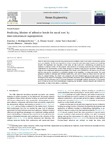Predicting lifetime of adhesive bonds for naval steel by time-temperature superposition

Ver/Abrir
Use este enlace para citar
http://hdl.handle.net/2183/39741
Excepto si se señala otra cosa, la licencia del ítem se describe como Atribución-NoComercial-SinDerivadas 4.0 Internacional
Colecciones
- Investigación (EPEF) [590]
Metadatos
Mostrar el registro completo del ítemTítulo
Predicting lifetime of adhesive bonds for naval steel by time-temperature superpositionAutor(es)
Fecha
2024-12-01Cita bibliográfica
Rodríguez-Dopico, F.J., Álvarez García, A., Tarrío-Saavedra, J., Meneses, A., Naya, S., 2024. Predicting lifetime of adhesive bonds for naval steel by time-temperature superposition. Ocean Engineering 313, 119482. https://doi.org/10.1016/j.oceaneng.2024.119482
Resumen
[Abstract] There is a lack of knowledge about the long-term behaviour of adhesive joints in the marine environment, and for hence, its reliability. The life cycle expected for a ship is twenty-five years and conduct duration tests would last decades. The importance and originality of this study are that it provides a methodology for predicting the durability of adhesive bonds. For this purpose, three adhesives for bonding naval steel were tested at several temperatures for determination of their shear strength on standard single-lap-joint specimens. Subsequently, using the time temperature superposition principle, these results were combined into one master curve for each adhesive that can be considered as a prediction method of the durability in a long-term period. The usual parametric models of Arrhenius and Williams-Landel-Ferry were used to obtain the master curve for each adhesive by manual shifting. The results were compared with those obtained applying an open-source software developed by the authors in R language, which specifically implements a non-parametric methodology based on the shift of the first derivative curves, following parameters of Explainable Artificial Intelligence. It was found a good correlation between both methodologies, supporting the durability lifetime obtained and therefore the applicability on ships of this adhesive technology.
Palabras clave
Adhesives
Lifetime
Shipbuilding
Time-temperature superposition
Machine learning
Explainable artificial intelligence
Lifetime
Shipbuilding
Time-temperature superposition
Machine learning
Explainable artificial intelligence
Versión del editor
Derechos
Atribución-NoComercial-SinDerivadas 4.0 Internacional
ISSN
1873-5258






